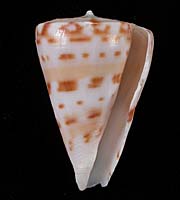|
< Previous family introduction |
|
|||||
 |
Family Conidae Cone shells
|
|||||
|
The family Conidae, commonly known as cone shells, consists of over 300 species, mainly occurring in the tropics. Shells of the tropical species are large and attractive, and have received the attention of conchologists for hundreds of years. The tropical species live on coral reefs where they occur under coral slabs or in sand or on the exposed reef surface; or on intertidal sand flats; or subtidally on sand and rubble. Fewer species occur in temperate zones, where they occur intertidally and in deeper water. The NSW fauna contains representatives of all of these groups. Cones are carnivorous animals, feeding on worms, other molluscs or small fish. They have a highly specialized feeding mechanism. The teeth on the radular ribbon of less advanced molluscs have been modified in the cones into hollow harpoons, which are stored in a tooth sac until needed. When required, a harpoon is pushed out to the end of the proboscis, being filled with poison from the poison gland on the way. The animal detects the presence of prey by using a sensitive organ, the osphradium, to "smell" the water current passing through the gill chamber. Once located, the prey is speared by the harpoon and the proboscis with prey attached is drawn into the mouth and the prey digested. The more poisonous species of cones, such as the tropical species Conus geographus and Conus striatus, are known to have caused human fatalities. All species of cones should be treated as potentially dangerous, although the sting of smaller species is likely to be no worse than a bee sting. Many cone species, particularly the widespread tropical species, show wide variation in shape and colour over their range. With hundreds of years of conchological attention, there are many synonyms for species in this family. The family has been treated in monographs for at least a century; the latest monograph, by Röckel, Korn & Kohn (see Family References below) has synthesized this information into a comprehensive treatment of the family, and includes ecological and behavioural information for coral reef species. There are 28 species of cones currently recorded from NSW, falling into three distinct distributional groups. The largest group consists of 16 species which are common and widespread in the tropical Indo-West Pacific faunal region, which includes Queensland. These are uncommon to rare in NSW, with the end of the range of most of them occurring in the north of the state, but a few reach as far south as Sydney. Further collecting will probably increase the number of these tropical strays known from northern NSW. The second group, consisting of eight species, are endemic to eastern Australia. These are the "tan cones", named for their colouring. They occur at depths of 50-250 m, ranging from southern Queensland to southern NSW, and are all uncommon to rare. The third group, of only four species, are relatively common intertidal or shallow subtidal animals on rocky shores, with ranges restricted to eastern or southern Australia. It is this group that makes up the majority of beach specimens seen in central and southern NSW. Family references:
Coverage All species of Conidae known to occur in NSW are illustrated here.
|